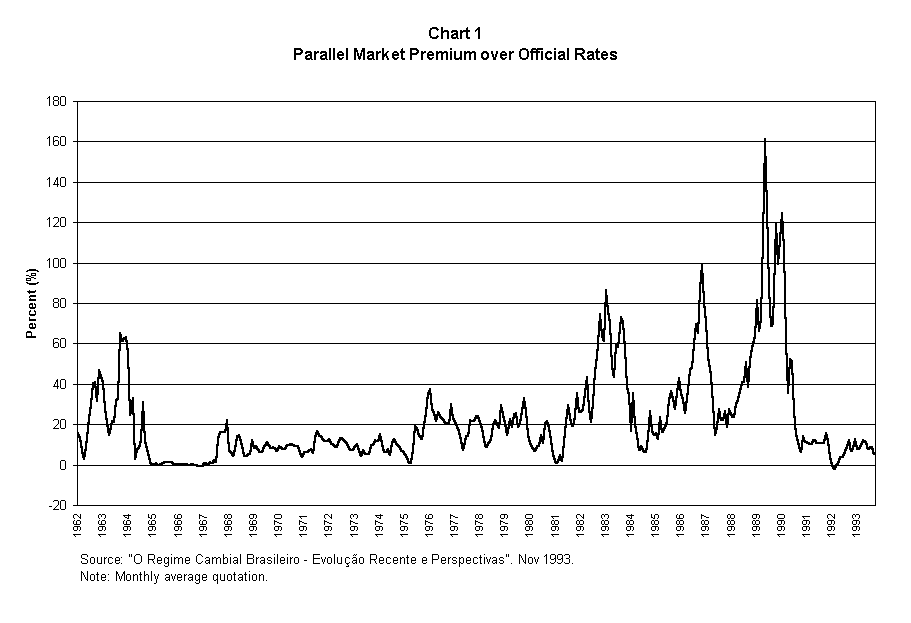
Instituto Cultural Minerva
IBI Institute of Brazilian Issues
The George Washington University
Washington, DC
Creation and Evolution of the "Flutuante" Exchange Rate Segment in Brazil
By Paulo M C Muniz
Minerva Program Spring 1998
TABLE OF CONTENTS
1. INTRODUCTION
The present structure of the Brazilian foreign exchange market is a result of changes ocurred in the late eighties just as foreign exchange controls began to present more flexibility. Indeed, the very first changes would come in the end of 1988 and beginning of 1989 with the creation of a new segment of foreign exchange market, the so-called Flutuante Exchange Rate Segment, or simply Flutuante for the sake of simplification. Thus, one could say that since 1989 Brazil has had an official dual exchange market, even though different from traditional models.
Usually, dual exchange markets embody the concept of distinct exchange rate for trade transactions and for financial transactions commercial rate and financial rate, respectively. The Brazilian regime renounced this standard in favor of a more pragmatic classification according to specific needs and strategy. Assurely, one of the main reasons for the creation of the Flutuante was to confront the enlargement of the parallel.
Thus, considering timing and suitability, this paper examines the process of the creation of the hereinafter-studied segment, Flutuante, its evolution and importance in the Brazilian foreign exchange market. More than an elaborate economic study, the purpose of this paper is to describe the process of creation and enhancement of this segment utilizing historical information and data provided by the Banco Central Information System - Sisbacen.
The study is divided into three sections. The next section (section 2) presents the pre-conditions and the process of creation of the Flutuante. Section 3 outlines the evolution of the new segment under the recent macroeconomic conditions brought by the "Plano Real". Finally, Section 4 provides an overall assessment of the current structure and insertion of the segment in the present Brazilian foreign exchange market framework.
2. CREATION OF THE FLUTUANTE EXCHANGE RATE SEGMENT
2.1. Environment
When the new segment was instituted, the parallel market exchange rate boasted a premium of around 64% over the official exchange rate, reaching 161% in May 1989 (chart 1). This huge increase of the premium might be attributed mainly to the growth of inflation associated with the broad range of exchange controls instituted in the 80s as a direct outcome of the balance of payment crisis. The increasing demand for foreign currency either for trade needs or for currency substitution as a store of value was clearly an incentive to the development of the parallel exchange market since scarcity prevailed.
Given the high level of capital controls under capital-account restrictions, the government had to determine special transactions to be prioritized, such as the import of oil. At this time, not surprisingly, some operations naturally took place at the parallel market level, even though some of those operations were morally justified. As an example, we can list health-related transfers or additional dollars for tourism.
Nevertheless, despite being illegal, the parallel market was accepted by society as an alternative market for foreign exchange, and it became a part of the Brazilian daily life. On the other hand, the dissemination of the parallel market made easier to transact unlawful operations typical of the black market (e.g. money laundering, fiscal evasion, etc).

As the middle eighties progressed, capital flows became more intensive and increased, pushing the negotiations through the parallel market. Meanwhile, the liquidity of this market was guaranteed by way of fraud in exports and imports operations mainly underinvoicing exports and overinvoicing imports, clandestine exports (e.g. soya, gold) and capital flows bypassing the monetary authority control. Then, as a response to the seemingly huge increase of the parallel market, the Brazilian Central Bank brought to light a new foreign exchange segment in the end of eighties, the Flutuante, more precisely in December 1988.
2.2. The Establishment and Early Years of the New Segment
The new segment was created by the National Monetary Council Resolution No. 1552, dated December 22, 1988, followed by the Central Bank Circular No. 1402, dated December 29, 1988. The latter document provided the procedures to the new segment, including the date of inception: January 9, 1989. The main innovations of the newly created segment were certainly the fluctuation of the exchange rate and broadening capital mobility.
Until then, the official exchange rate followed a crawling peg regime, where the rate was adjusted little by little, and determined by governmental intervention, seemingly according to the power purchase parity. This regime lasted from August 1968 up to March 1990, when another important change happened in the Brazilian foreign exchange market. By the National Monetary Council Resolution No.1690, dated March 18, 1990, the Segmento de Taxas Livres was created, which, in reality, represented a revision of the then existent official market.
In the new environment, Central Bank abandoned the formal establishment of the exchange rate and became a participant in the market with substantial authority, convenient to the desired exchange policy and international reserve stock needs. In fact, in 1991, the Central Bank began to intervene in the market, initially with gold operations and then through informal auctions of foreign currency.
Thereafter, as mentioned before, the Brazilian foreign exchange market presented a well-defined structure of a dual exchange market, apart the parallel market, as showed by chart 2. The creation of the Flutuante brought a mechanism that allowed flows from and to the parallel market, with special concern with licit operations. The truth is that one of the main goals of the new segment was to provide a link with the parallel market and, consequently, draw licit operations to the official market, more precisely to the newly created segment.
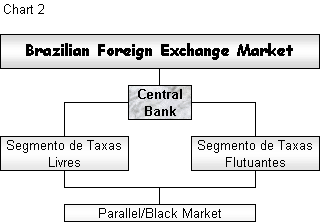
At the very beginning, the first step was to regulate and bring all transactions related to tourism to the official market, leading the denomination "tourism dollar" to be a byword for the Flutuante. Indeed, there was a limit of US$ 4,000.00 for each Brazilian for tourism and US$ 8,000.00 for personal credit cards, both reasonable limits for this kind of transactions. Yet, This limit was raised to National Congress and Judiciary members. In the case of health treatment abroad the limit was set at US$ 100,000.00, and for residents maintenance abroad the value reached US$ 4,000.00.
Concerning interbank operations, the new regulation permitted authorized institutions to negotiate foreign currency among them, under mandatory identification. These institutions were also allowed to negotiate foreign currency with financial institutions abroad using domestic currency, under the same exigency of identification. This type of negotiation, crucial and prevalent in this segment nowadays, became an important element in the recent development of the Brazilian foreign exchange market, representing a real widening in capital mobility, which will be discussed later.
To succeed in making possible a channel between the parallel and the Flutuante, the anonymous sale of foreign currency was allowed to specifically authorized institutions through the new segment, up to the limit of US$ 10,000.00. Since there was no need of identification in this specific case, the main reasons for economic agents to remain negotiating in the parallel would be the difference between the two rates (arbitrage) and the possibility of conducting illegal operations.
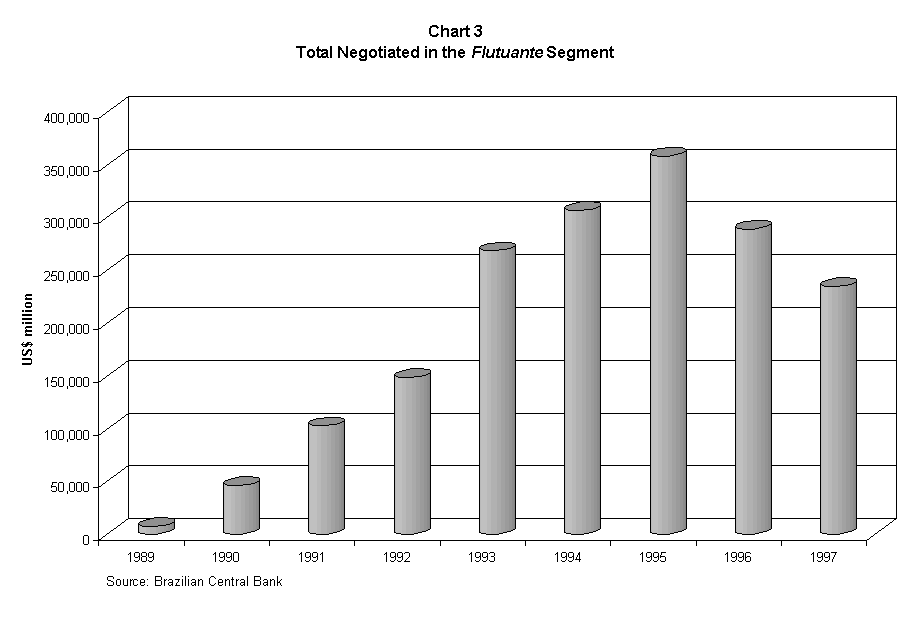
However, another characteristic of the Flutuante involved exactly the free fluctuation of exchange rate, which would be determined for the market forces, similarly to the parallel market. However, all the operations were required to be registered in the Central Bank, providing statistics that were unknown before the new segment was introduced. Moreover, the link between the two markets together with the floating rate would naturally tend to equalize the rates. From this point on, with the flexibility created in the foreign exchange market, there was no more incentive to conducts negotiations in the parallel market, except for illegal operations mainly, as mentioned before.
Chart 3 shows clearly the huge increase of the new segment since its beginning, denoting success of the new strategy. From 1989 to 1995 the expansion was steadily increasing, reversing the course only in 1996 as a result of measures adopted to restrict short-term inflows, that is, speculative capital. Enlargements were observed overall, especially in the secondary operations interbank among Brazilian institutions and arbitrage (gold and foreign currencies) operations.
At this point, we should emphasize the importance of establishing gold arbitrage mechanism as an important fact in the Brazilian foreign exchange market, mainly related to the Flutuante. As we saw, the creation of this segment provided a draining of lawful operations from the parallel to the official market, but surely the gold arbitrage mechanism enhanced this flow by efficiently equalizing the rates between the two markets.
The gold and parallel/black dollar market have always been closely related in Brazil. More precisely, agents were used to export gold clandestinely to Uruguay and sold the resulting dollar in the Brazilian black market. In charts 1 and 4 we can fairly compare the effects of official gold operations in both the parallel exchange rate premium over the official exchange rate and gold exports from Uruguay.
In the first chart, we can observe an intense drop in the premium just when Central Bank began consistently to run gold operations. In the latter chart, the sharp decrease in the Uruguay gold exports can be noticed, showing clearly that, in reality, this gold seemed to be originally from Brazil and directly linked to the black market operations.
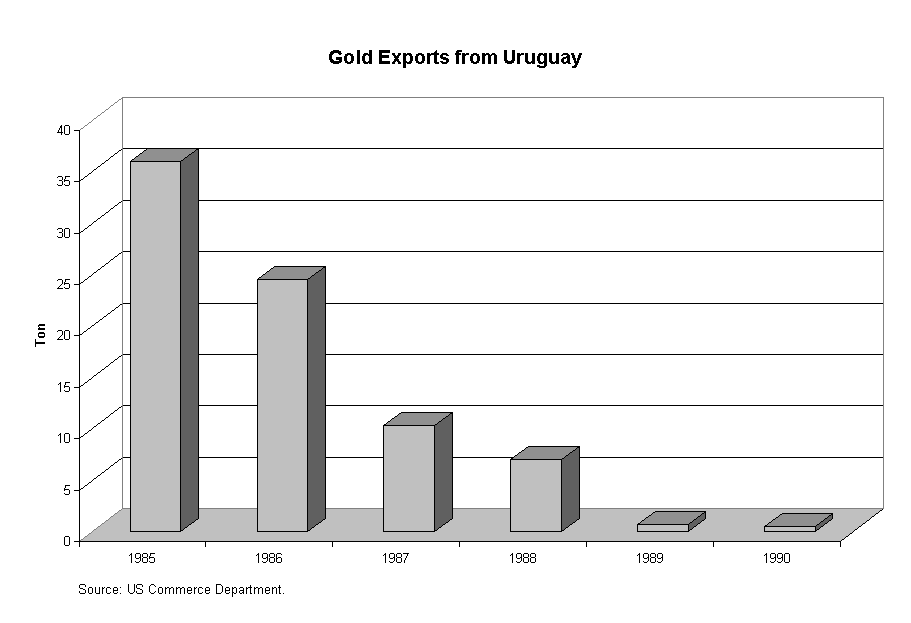
Besides, it is important to mention the effectiveness and appropriateness use of those gold operations as far as a change of gold for foreign currency or vice-versa didnt affected the level of international reserves. It was simply an exchange of assets.
Yet, it must be emphasized that the whole process from the creation of the Flutuante till the virtual completion of the parallel occurred gradually, amplifying the range as the market showed maturity and required enhancement. Nevertheless, despite all the improvements involving the segment during the years, nowadays the most principal subject entails the concept of non-residents account, the former so-called CC5, which provided a broader capital mobility.
The name CC5 was originated from the abbreviation of Carta-Circular No.5, dated February 27, 1969. At the time when it was issued, in its original essence, the CC5 was in reality restrictive and was enacted to regulate the transference of domestic currency abroad settled by the Decree No. 55762, dated February 17, 1965. By this document, the remittances to other countries from accounts in Brazil of individuals and firms residents abroad were free, independent of authorization. However, to have this mobility, the money to be transferred should have been originated from previous inflow and conversion into the domestic currency.
Nowadays, the Carta Circular No. 5 has been resigned and replaced by the Circular No. 2677, dated April 10, 1996, which embodies more elaborate and accurate determinations involving non-resident accounts.
With the creation of the Flutuante segment, the mechanism involving non-residents account was improved, aiming to amplify the capital mobility in a magnitude without any precedents. The new segment brought the faculty to authorized banks for buying and selling foreign currency with financial institutions abroad using domestic currency, which, in reality, corresponded to the free capital mobility.
In fact, according to the new rules, if the non-resident is a financial institution, the balance of its account in domestic currency can anytime be converted into foreign currency and remitted to other country. The chart 5 following gives a rough example of the scheme of inflows and outflows through the negotiation between a domestic and a US financial institutions (so-called international interbank market).
In the given example, if an American bank wants to send capital to Brazil, it can simply buy the Brazilian currency (real) by transferring the dollar to the Brazilian bank. Following, this bank credits the equivalent in reais in the non-resident account of the American bank, in Brazil. At this moment, the deposit of reais in the American bank account is considered as an international transfer of national currency, since it is now an asset from the foreign institution. It can decide what to do with the money without any restriction but to comply with all fiscal requirements and record all operations in the Banco Central Information System Sisbacen. In the case of inflow, the same procedures are followed in the opposite direction.
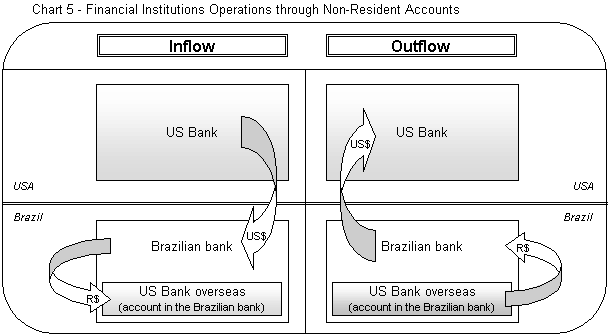
Nevertheless, the broadening of capital flows reached not just financial institutions; that is, every economic agent could benefit from this capital mobility. Even though the norms allowed just non-resident financial institutions to make free international transference, the mechanism also served to other agents, which would operate through financial institutions, as exemplified for the case of an outflow in the chart 6.
In the illustration, to make a transfer to the USA the agent should deposit the amount in reais in a non-resident account of an American financial institution. After that, the Brazilian bank, which holds the account of the American financial institution, converts the reais into dollars and sends them to the USA. The next step is simply the payment to the final non-financial agent.
Once again we should emphasize that all operations must be recorded at the Banco Central Information System - Sisbacen. Yet, it must be stressed that the possibility and effective transfer didnt mean legalizing the money involved. Instead, it still remains the feasibility of prosecution in case of illegal transfer or money origin.
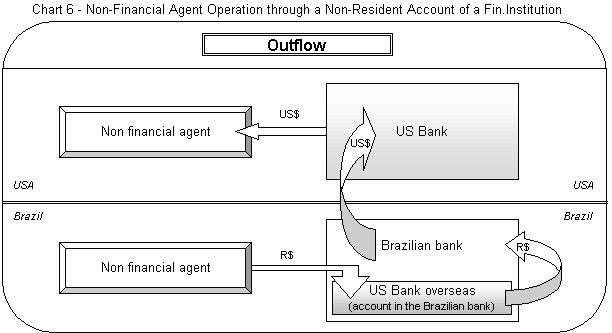
Although the mechanism seems to be a channel for capital flight, one should argue that this doesnt really induce this kind of operations, which could be done through the parallel, likely as it used to be before. On the contrary what the existence of such operations implies is that the government began to have an important source of data to rely on since all the transactions should be now recorded. Moreover, so much possibility of capital movement represented in fact an encouragement to bring back Brazilian resources held abroad since the same capital could take advantage from domestic interest rates or investment opportunities and be send back whenever required.
3. "PLANO REAL" AND THE FLUTUANTE EXCHANGE RATE SEGMENT
On July 1, 1994, Brazil experienced a change of its currency as an important step of the macroeconomic plan so-called "Plano Real", which, in reality, is a whole process that began in mid 93s with an emergency fiscal adjustment. Following, in the beginning of 1994, it was introduced a mechanism that guaranteed the transition toward the new currency real, intended to be the currency of a stabilized economy. The final process foreseen by the plan corresponds to the structural reforms, actually still taking place.
Despite the "Plano Real" should be consider as a whole process, here well consider July 1, 1994 as the beginning of it since this is the date of issue of the new currency and of the Medida Provisória No. 542, which stated all the regulations involving this macroeconomic plan.
With a more stabilized economy, Brazil became one of the most attractive emerging countries for foreign investors and, truly, attracting capital was a very important foundation of stabilizing process; either for direct investments or short-term capital, compensating current account deficits.
Concerning the exchange policy, the first effect experienced for the market after July 1, was the immediate appreciation of the real, caused by the huge financial inflows and absence of the monetary authority. Indeed, till September 1994 there was no intervention in the market, providing a really free-flexible exchange rate regime during this period. The purpose of this policy was to provide enough freedom to the market and also curtail the practice of price indexing based on exchange rate growth.
However, as pressures became stronger, threatening aimed results in the balance of payments, the Central Bank had to intervene by acquiring the excess supply of dollar and establishing a policy of gradual adjustment in the exchange rate, intervening whenever conditions indicated the existence of imbalances
In this whole process, the Flutuante Exchange Rate Segment played a very important role since it works as an indicator of the short-term capital trends in the market as well as a sign of mobility of Brazilian foreign exchange market. In the chart 7 following, we can see the flow recorded through this segment from January 1994 till December 1997. As it will be showed, all the disturbances occurred in the Brazilian economy, mainly in the exchange market, had a clear reflect in the Flutuante, denoting its undeniable relevancy.
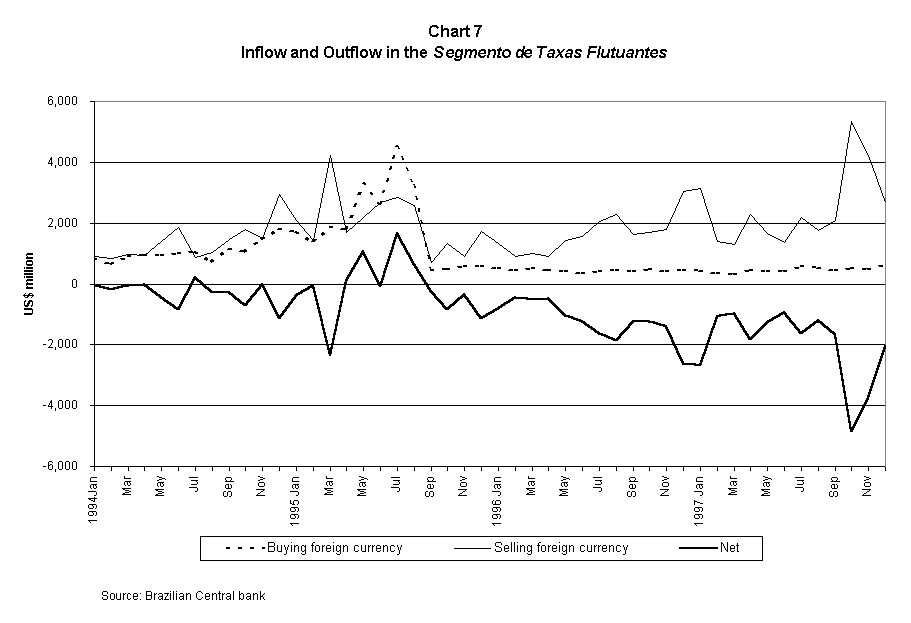
However, the most relevant operations refer to interbank operations with financial institutions abroad, precisely the operations involving the mentioned non-resident accounts. As we intend to show the capital flows via the Flutuante segment, we decide for separate this type of transference from the so-called Client Operations, usually not related to financial involvement. Actually, we can conclude by comparison between the charts 7 and 8 that the participation of Client Operations in the segment is more relevant in the inflows, mainly if considered the period beginning in September 1995.
The chart 8 clearly shows the increasing trend in the financial flows through the Flutuante from August 1994, just as the Real Plan was implemented. As mentioned before, the chart encompasses the operations referred to interbank operations with financial institutions abroad. We can see that both inflows and outflows grown during the period, denoting the broad participation of short-term capital. In December 1994 and March 1995 we can observe a huge increase in outflow as a result of Mexico crisis and the adoption of an adjustable band regime (taget zones).
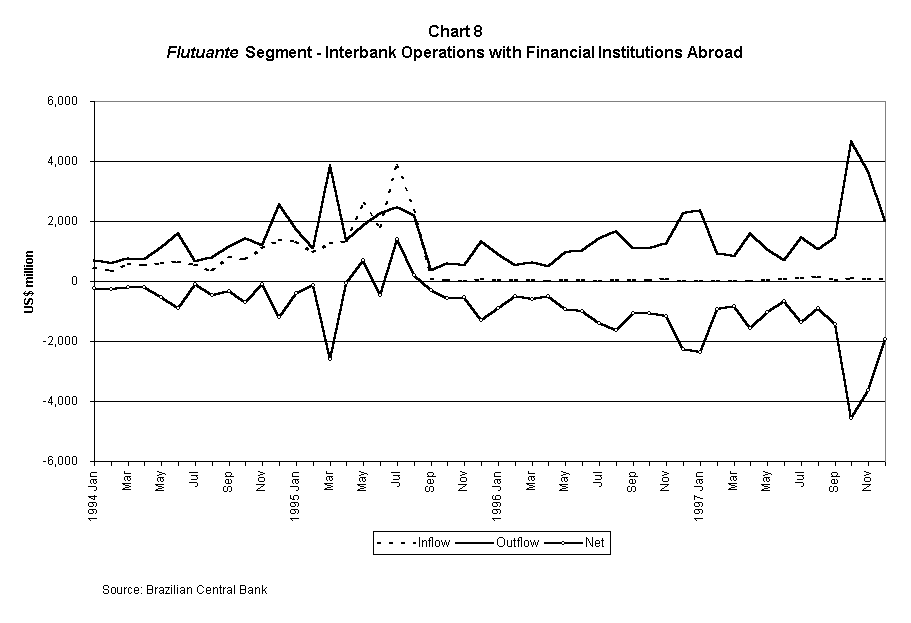
In the first case, there was repatriation of investments held in Brazil to cover losses suffered abroad. In addition, investors were afraid that a contamination in the Brazilian economy would result in devaluation of the national currency. In March, expectations were also responsible for the huge outflow. The adoption of the adjustable bands was misinterpreted by the market, creating expectations of exchange policy alterations and a possible sharp adjustment in exchange rates.
Nevertheless, the capital briefly returned to Brazil in the following months at an extent that forced the establishment of a 7% tax over inflows through interbank operations with financial institutions abroad. Immediately, as expected, foreign resources virtually stopped the inflows via these operations. This measure provided a relief in the needs of sterilization by Central Bank meanwhile granted a selection of the capital influx since such a tax discouraged short-term capital investment. Since then, this segment has presenting consistent net outflows, as observed in the chart 8, specially in November and December 1997, when it was observed a huge increase in the remittances due to the Asian crisis.
Once more the flows in the Flutuante presented an immediate reaction to the conjectural factors, reinforcing the idea of free capital mobility. Indeed, the only element that determines the direction and level of transfers end up being the reliance of the agents in the economy, and, thus, the intervening of the monetary authority.
At the same extent that this segment was very important to bring operations from the parallel market, it plays a significant role in the success of the macro stabilization plan. Either as a thermometer of short-term capital flows or as a window to have access to this kind of capital whenever is required, in addition to portfolio and direct investment.
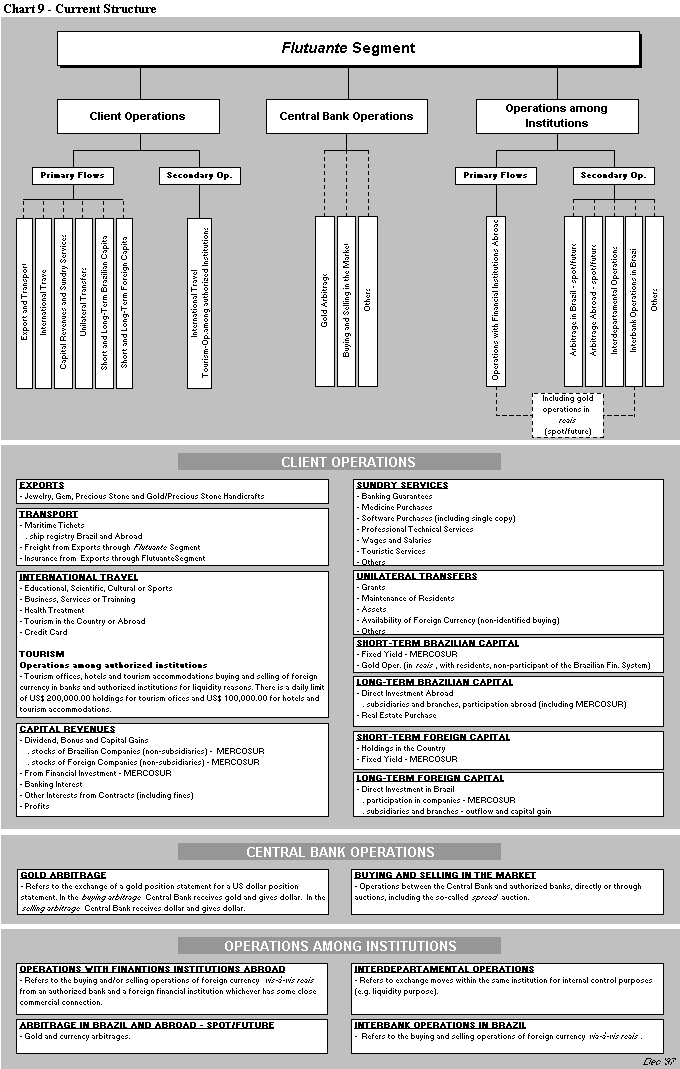
4. CURRENT STRUCTURE AND INSERTION IN THE EXCHANGE MARKET
The present structure of the Flutuante is depicted in the chart 9, where we can have a very good notion of the operations here negotiated. Since 1989 it has becoming more elaborated and specialized, complementing perfectly the other segment in a way that both segments together overwhelm implicitly all the licit operations running in the Brazilian foreign exchange market. It has become so extended that nowadays there is absolutely no reason to negotiate in the parallel market. One could say that just unlawful operations are negotiated in that market, that is, in the real meaning of black market.
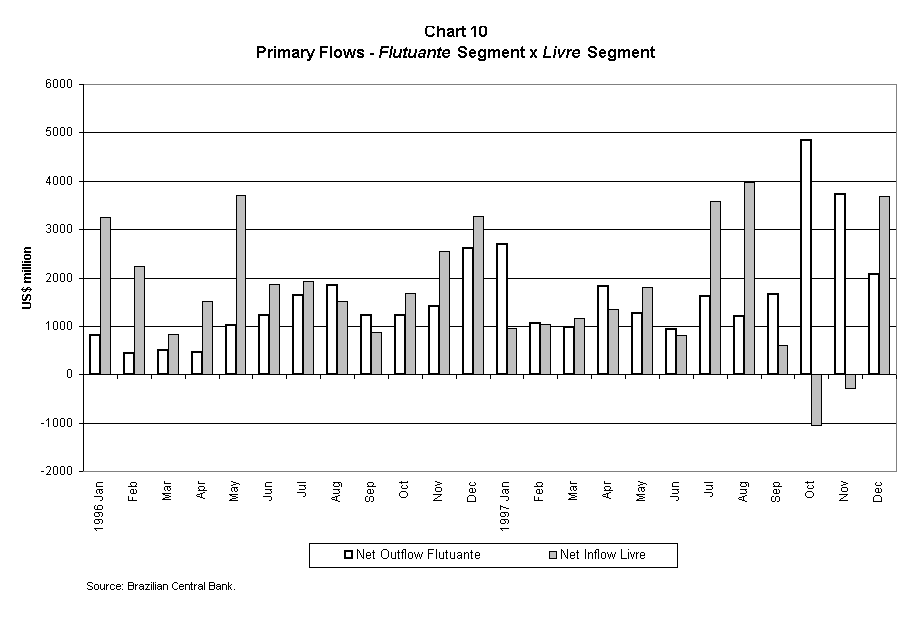
Considering the exchange market as a whole, that is, the two segments altogether Livre (free) and Flutuante (floating) , it would result in a low participation of the Flutuante in the operations, mainly for the relative low level of negotiations in the domestic interbank exchange market. The representativeness reaches the average of 11% or 12%, if we take 1996 and 1997 as an example.
On the other hand, if we consider just the primary flows, we can see that the Flutuante has a more important share in the exchange market. In this case, as observed in the chart 10, the net flow in this segment sometimes seemingly compensates the net flow in the Livre segment. Usually the Livre segment has been presenting net inflows while the Flutuante has been presenting net outflows.
As Central Bank has been intervening in both markets, it ends up to reallocate liquidity in the system, providing a minimum difference between the two exchange rates and avoiding speculation through arbitrage between the two markets. In other words, the Central Bank has been doing the perfect linkage between the two segments, working as a "unification agent" in the market.
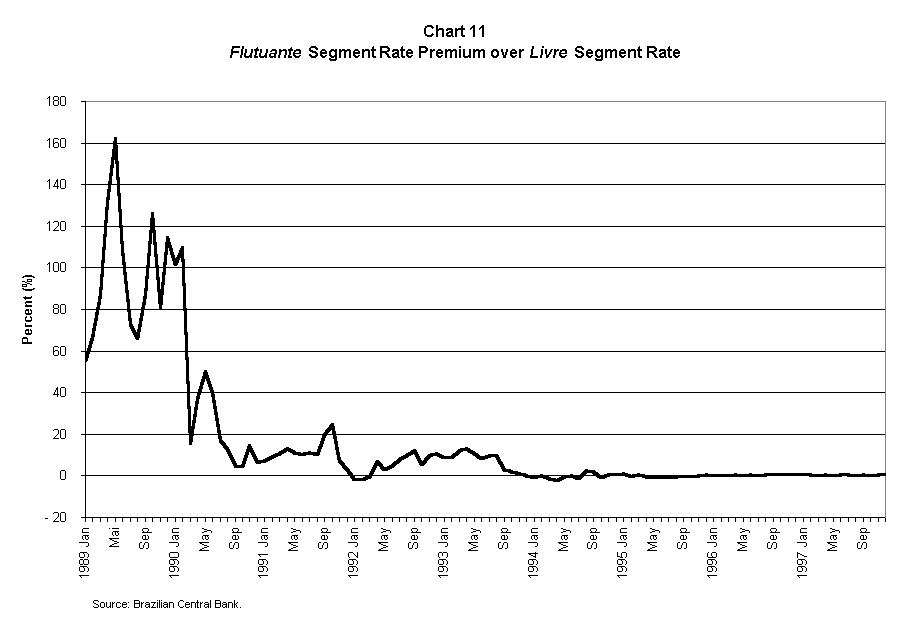
As we can see in the chart 11, nowadays the premium of the Flutuante segment exchange rate over the Livre segment exchange rate is virtually null since the last years, mainly due to the mentioned intervention of the Central Bank in the two markets. If compared to the chart 1, it is clear that the fall of the Flutuante premium over the official rates follows the drop of the parallel premium over the official rates.
The effective equalization between the exchange rates of the Flutuante and Livre segments is a very important figure in the Brazilian foreign exchange market. It really works as the most efficient disincentive for agents to arbitrage between the two rates as usually happened in accordance with the law or even illegally.
5. CONCLUSION
The purpose of this paper has been to give a rough description of the process of creation and evolution of the Flutuantes Exchange Rate Segment, a new foreign exchange segment stated in the very beginning of 1989. Not surprisingly, we conclude for the efficiency of the new segment in confronting the parallel market, grabbing licit operations from this market to the official one meanwhile eliminates the premium of the parallel rate over the official.
Further, it had the advantage of intensifying free capital mobility through the improvement of a mechanism involving international transfers, following the international tendency and supporting the broader openness of the Brazilian economy.
Although the new segment does not represent a very representative share in the Brazilian foreign exchange market if considered all operations, it is undeniable its importance when involved primary flows. Alternatively, it can be even considered as a thermometer for short-term capital flows; furnishing instruments to fine tuning this type of flows.
Finally, we must stress the link in the two segments provided by the Central Bank intervening from which is granted the needs of liquidity in both markets, given the strategies of the monetary authority. Even though one could argue that the market would be seemingly more efficient by itself, this is not guaranteed in the actual circumstances of non-steady stability of the Brazilian economy and its foreign exchange market.
After nine years of existence, considering the low participation of the parallel the Brazilian foreign exchange market and the very small possibility of arbitrage between two rates, we can say that the creation of the Flutuante was a very positive fact to the economy. On the one hand, it succeeded by draining the strength of the parallel and bringing to legality all the licit and morally justified operations. On the other, the authorities gave the precise vigor to the new segment, avoiding at the same time its uncontrolled growth that would bring some considerable noisy to the market, as continuos arbitrage, for instance.
Banco Central do Brasil, "Análise Trimestral do Mercado de Câmbio," several editions.
Banco Central do Brasil, Annual Report, several editions.
Banco Central do Brasil (1996), "Banco Central do Brasil and the First two Years of the Real," July.
Banco Central do Brasil, Consolidation of Exchange Norms.
Banco Central do Brasil, Monthly Bulletin, several editions.
Banco Central do Brasil (1993), "Regime Cambial Brasileiro Evolução Recente e Perspectivas", November.
Franco, Gustavo (1995), "O Plano Real e Outros Ensaios", Livraria Francisco Alves Editora.
Kessel, Moysés (1997), "Regimes Cambiais e Políticas Cambiais Brasileiras", Resenha Econômica, September.
Oliveira, Gesner (1996), "Brasil Real Desafios da Pós-estabilização na Virada do Milênio", Editora Mandarim.
Siqueira, Geraldo Magela (1993), "Evolução Cambial no Brasil: 1980 a 1993", Banco Central do Brasil.